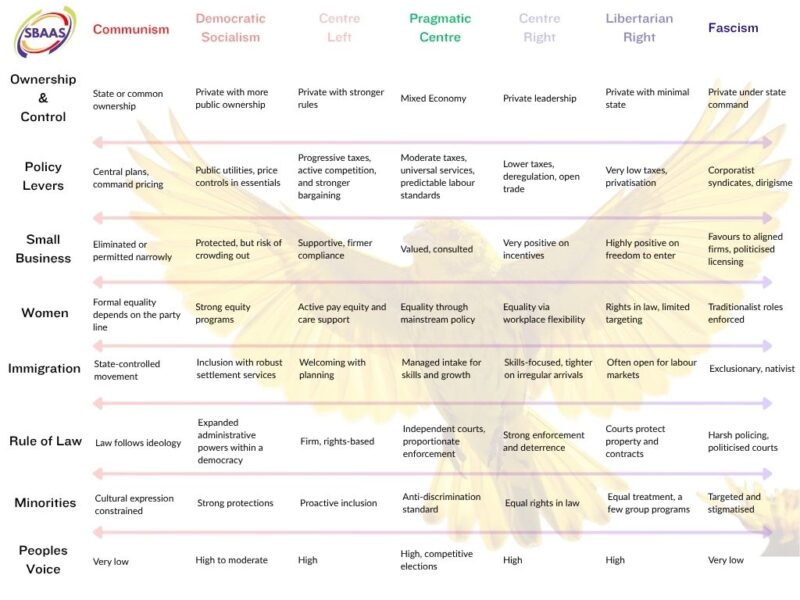From Centre to the Edges: A Practical Guide to the Political Left to Right Scale for Australians
Before we start, just quickly
I am writing this because our public language is being bent to breaking. On social media, in traditional media, and even on news channels, words are stretched to fit agendas.
Some voices are gaslighting, recutting definitions, and rewriting stories to suit themselves:
- Achievements appear from thin air.
- Failures vanish.
- Tiny blemishes are polished until they sparkle.
House rules, briefly. If facts ruin a good outburst, this is not for you. If you prefer ad hominem to argument, or love a strawman grabbed out of context, you will hate what follows. Past this note, you will find very little opinion. You will find clear definitions, testable claims and sources you can check.
This is how I work with clients. We investigate every ‘truth’ before we act, so leaders receive an honest view of their business and a way forward. The same method applies here. I pull the claims apart, test them against evidence, then, and only then, draw a line on the map.
For the record, I hold post-graduate qualifications in Education, Business and Law. I still check every view against real data. I use logic and plain reasoning before I accept a claim. I am confident in that process. I am not arrogant enough to believe I am always right. Knowledge changes. So do I, when credible evidence demands it.
You will find every source at the end. Please read them. Check my steps. If better information exists, I will adjust the work and say so. If you came for a team cheer squad, you may be disappointed. If you came for a clear map, welcome.

Words … they mean stuff, so here’s an overview
Clear terms help readers place ideas correctly on the political left-to-right scale. The definitions below are designed to use plain language and remove the ‘jargon’ for clarity.
- Pluralism: A system where different groups, views and interests can compete and cooperate. Elections are genuine. Opposition parties, independent media and civil groups can operate.
- Rule of law: The idea that rules are clear, public and apply to everyone, including leaders. Courts are independent. Police powers are limited by law.
- Authoritarianism: Power concentrates in the executive. Opposition and media face pressure or limits. Elections may exist, but the contest is not fair.
- Totalitarianism: An extreme form of control where the state seeks to dominate politics, the economy and daily life. Independent organisations are not allowed.
- Corporatism: An economic order where the state organises employers and workers into state-approved bodies. Private property exists, but the state sets the binding direction.
- Social democracy: A centre-left tradition that accepts markets, supports strong public services and sets firmer labour standards.
- Democratic socialism: A more left position that expands public ownership in strategic sectors and uses stronger price or rent controls.
- Libertarianism: A right-leaning philosophy that seeks a very small state. Markets and private choice lead.
- Fascism: An extreme right position built on nationalism, hierarchy and leader worship. Private property remains, yet the state commands it.
- Communism: An extreme left position that replaces private ownership of productive assets with state or common ownership and central planning.
These definitions are signposts. They will help you map statements and policies onto the political left-to-right scale without guesswork.
Start in the middle: the practical, pro-enterprise centre
Most businesses operate near the pragmatic centre. Here, the political left-to-right scale supports a mixed economy, clear competition rules and baseline protections. The public sector funds health, education and safety. Private enterprise invests, hires and innovates.
Typical policy levers in the centre
- Moderate tax and a stable company‑tax framework.
- Targeted small‑business relief, for example, simplified depreciation or concessional rates for smaller entities.
- Universal services that support a healthy, skilled workforce.
- Predictable labour standards and dispute systems.
Typical attitudes in the centre
- Small business: Valued as the backbone of jobs and local activity. Consultation is routine.
- Women: Equality goals sit within mainstream policy, with parental leave, pay equity tools and flexible work.
- Immigration: Managed intake supports skills and population growth.
- Rule of law: Strong and even-handed. Courts and regulators are independent.
- Minorities: Anti-discrimination is standard. Inclusion is a civic norm.
- Voice of the people: High. Elections are competitive. Media and civil groups operate freely.
The centre balances efficiency and fairness. It also anchors the language we use. If you understand the centre, you can place claims about the “far left” or “far right” on the political left-to-right scale with confidence.
Move left from the centre: centre-left social democracy
The first step left emphasises a fair market with stronger rules for wages, safety and competition. Private ownership stays. The state invests more in services and sets clearer baselines.
Policy themes
- Stronger collective bargaining and minimum standards.
- Progressive taxes to fund universal services and infrastructure.
- Active competition policy to curb unfair dominance.
- Expanded human‑capital investment, for example, TAFE and skills.
Tell‑tale attitudes
- Small business: Supportive but firmer on compliance. Grants, advisory services and procurement access matter.
- Women: Gender equality is a priority. Pay transparency and childcare support expand.
- Immigration: Welcoming, with guardrails. Skills planning is prominent.
- Rule of law: Firm but rights-based. Emphasis on procedural fairness.
- Minorities: Active inclusion, anti-discrimination enforcement, equal civic voice.
- Voice of the people: High. Policy seeks broader participation.
Practical effects for SMEs
- More predictable labour rules, clearer competition settings and stronger baseline demand through public services.
- Higher documentation effort and HR maturity.
- Easier access to training and advice programs.
Use the political left-to-right scale here to decode headlines. Many policies described as “radical” overseas are, by Australian and OECD standards, close to this centre-left band.
Move further left: democratic socialism.
Another step left, democratic socialism expands public ownership or control in strategic sectors. Prices and rents may be regulated. Unions gain larger roles in bargaining.
Policy themes
- Public ownership for utilities or critical assets.
- Price or rent controls in essential to stabilise living costs.
- Expanded welfare or public employment in downturns.
Tell‑tale attitudes
- Small business: Protected where markets are fragile, yet risk of crowding out by public providers.
- Women: Strong focus on equity and public care services.
- Immigration: Inclusionary framing, stronger settlement services.
- Rule of law: Legal powers expand for economic management, still within democratic bounds.
- Minorities: Proactive rights protection and representation.
- Voice of the people: High to moderate. Elections are competitive, yet administrative power grows.
SME implications
- Potentially cheaper inputs if public utilities are efficient.
- Slower approvals if large public monopolies dominate gateways.
- Tighter margin control in sectors with price caps.
The political left-to-right scale helps here, too. The journey is still inside a democratic frame, but with more state direction of the economy.
The far left endpoint: communism
At the extreme left of the political left-to-right scale sits communism. Private ownership of productive assets is abolished in favour of state or common ownership. Central planners direct production, pricing and trade.
Tell‑tale attitudes
- Small business: Private enterprise is eliminated or allowed only as a narrow exception. Licensing is political.
- Women: Formal equality is often declared, but rights depend on party alignment.
- Immigration: Controlled almost entirely by the state, with limits on exit and entry.
- Rule of law: Law follows ideology. Courts lack independence.
- Minorities: Cultural and religious expression is restricted when it conflicts with doctrine.
- Voice of the people: Very low. One party dominates public life. Elections, if held, are not competitive.
SME implications
- Loss of ownership and contracting freedom.
- Rationed inputs and politicised access to credit and licences.
- High risk for independent associations or advocacy.
This destination and the fascist endpoint travel different economic roads, yet both converge on centralised political power and a weak civic voice.
Move right from the centre: centre-right liberal conservatism
The first step right prioritises market dynamism. Taxes are lower where feasible. Regulation aims to be simpler. Tradition and order receive greater weight.
Policy themes
- Lower company and personal tax rates, subject to budget space.
- Deregulation and “red tape” reduction for approvals and reporting.
- Strong support for private investment and open trade.
- Law‑and‑order spending and border integrity.
Tell‑tale attitudes
- Small business: Very positive. Focus on incentives, entrepreneurship and cash‑flow relief.
- Women: Equality remains important, often through workplace choice and flexible settings.
- Immigration: Skills-focused intake, tighter approaches to irregular arrivals.
- Rule of law: Strong. Emphasis on enforcement and deterrence.
- Minorities: Equal rights in law, with greater caution on identity-based policy.
- Voice of the people: High. Reforms seek mandate through elections and consultation.
SME implications
- Lower compliance costs and faster approvals.
- Stronger exposure to larger incumbents if competition rules loosen too far.
- More scope to innovate and retain earnings.
The political left-to-right scale suggests this band is still recognisably democratic, market-oriented and pluralist.
Move further right: libertarian and market‑maximal views
Another step right seeks a minimal state. Property rights, contract and security are core. Many services shift to private delivery.
Policy themes
- Very low taxes and light-touch regulation.
- Broad privatisation and user‑choice models.
- Strong protection of speech, association and contract.
Tell‑tale attitudes
- Small business: Highly positive on freedom to enter and compete, yet low protection against powerful firms.
- Women: Rights protected in law, with limited targeted intervention.
- Immigration: Often open for labour markets, yet views vary.
- Rule of law: Courts protect property and contract above other aims.
- Minorities: Equal treatment in law, fewer group-specific programs.
- Voice of the people: High. State is small, so many choices sit with individuals and firms.
SME implications
- Compliance is light, margins depend on market power, and caveat emptor is common.
- Consumers and workers face higher buyer‑ and worker‑beware risk.
This position remains within the democratic space of the political left-to-right scale. It differs by trusting markets much more than the centre.
The far right endpoint: fascism and state corporatism
At the extreme right of the political left-to-right scale sits fascism. Property remains private, but the state commands it. Regimes build corporatist syndicates, suppress free unions and concentrate power in a leader and party.
Tell‑tale attitudes
- Small business: Favours flow to aligned firms, yet licensing and supply become politicised. Independent associations are not free.
- Women: Rhetoric emphasises traditional roles. Rights are contingent on conformity.
- Immigration: Nativist and exclusionary. Minority communities face suspicion and pressure.
- Rule of law: Law is a tool of power. Policing is harsh. Courts lack independence.
- Minorities: Targeted and marginalised. Media narratives stigmatise difference.
- Voice of the people: Very low. Elections are manipulated or replaced by plebiscites without real choice.
SME implications
- Cartelisation and state direction squeeze independent firms.
- Contract and property rights depend on political loyalty.
- Market entry and finance are permission-based.
As on the far left, the endpoint is dictatorship in practice, even if economic forms differ.
A side-by-side map of the journey
Use this table to locate policies and attitudes along the political left-to-right scale. Read from the centre outward.

How labels drift, and why context matters
Language moves with politics. In some debates, especially in the United States, a public health “option” was described as “far left”. In comparative terms, it sits near the centre. Australia’s universal coverage and private choice show that broad access can coexist with markets.
The reverse also occurs. Critics sometimes call mainstream conservative parties “far right”. In Australia, major parties are usually described as centre-left or centre-right. Smaller parties to the left or right pull debate, yet they operate within pluralist rules. Knowing these anchors stops the language from sliding off the political left-to-right scale.
For business readers, the key is to identify the substance:
- Who owns assets?
- Who sets prices?
- Which rules change wages, safety and competition?
- Whether dissent is punished.
These tests place a claim on the political left-to-right scale better than slogans ever will.
Toward the left
- Small business: From supportive, to more regulated, to replaced by state provision at the extreme.
- Women: From mainstream equality, to strong equity programs, to rights tied to ideology at the endpoint.
- Immigration: From planned and skills-based, to inclusionary with high support, to state-controlled movement.
- Rule of law: From independent courts, to stronger administrative powers, to law as ideology.
- Minorities: From protected, to actively included, to constrained and monitored in the extreme.
Toward the right
- Small business: From supportive, to highly free, to politicised favouritism within state-controlled cartels at the endpoint.
- Women: From mainstream equality, to rights protected but limited targeted programs, to traditionalist roles enforced.
- Immigration: From planned and skills-based, to market-driven openness in some views, to exclusionary nativism.
- Rule of law: From strong and even-handed to property-centred courts, to harsh policing and politicised justice.
- Minorities: From protected, to equal in law without group programs, to targeted and stigmatised.
This pattern shows why the political left-to-right scale is useful. It is not about team colours. It is about how power is used, how markets function and how citizens participate.
Where, exactly, does the public voice fade?
Public voice fades when rules change who can speak and how power is checked. The milestones below mark the shift on the political left-to-right scale.
- Centre to centre‑left and centre‑right: Voice remains high. Elections are fair. Courts and media are free.
- Democratic socialism and libertarian right: Voice remains high to moderate. The state may be bigger or smaller, yet pluralist checks still work.
- Approaching the extremes: Voice declines when governments restrict independent media, civil groups, unions, business associations or opposition parties.
- At the endpoints: Voice is very low. Elections do not offer a real choice. Courts are not independent. Policing is harsh and political.
When you hear claims about “the people” being in charge, test whether independent institutions still work. If the contest is real, the voice remains. If the contest is theatre, voice has already faded.
What this means for planning and risk
You do not run a party room. You run a balance sheet. The political left-to-right scale helps you prioritise what matters operationally.
Leadership and governance
- Build plans for centre‑left and centre‑right settings. Both are normal in Australia.
- Track changes to competition policy, privacy and workplace relations.
- Prepare checklists for contract, licensing and audit requirements.
Finance and operations
- Treat compliance as a system. Templates and training stop rules are becoming a crisis.
- Stress‑test cash flow for tax, wage and interest changes.
- Diversify finance to avoid missed growth windows.
People and culture
- Invest in supervisor training. Documentation prevents disputes.
- Use transparent pay structures. They improve trust and reduce turnover.
- Create channels for staff voice. It mirrors civic pluralism inside the firm.
The details above remain practical no matter who wins an election. That is the strength of working from the centre of the political left-to-right scale.
Why accusations of “bias” miss the point
One of the most common phrases heard when a reasoned article like this appears is that the authors are biased and should “do your own research”. We did our research. We are sharing it here and welcome everyone to review where we obtained our data and information. The Sources section lists every reference, with full web addresses for your review.
Why the political left-to-right scale belongs in your toolkit
The term appears throughout this article for a reason. The political left-to-right scale is a simple map. It helps you translate headlines into operating risk. It clarifies where policy sits today, where it might shift tomorrow and how that affects hiring, pricing and investment. It also filters label inflation. When someone calls a centrist policy “extreme”, the scale shows you otherwise.
Use it in board packs, staff briefings and planning days. Refer to it when lobbyists and commentators speak. Teach it to future managers. The political left-to-right scale will not decide your strategy. It will reduce noise, reveal the signal and free time to lead.
Sources
Australian Government Department of Employment and Workplace Relations. (2022). Secure Jobs, Better Pay. https://www.dewr.gov.au/secure-jobs-better-pay
Australian Government Fair Work Commission. (2025). Secure Jobs, Better Pay Act, what’s changing. https://www.fwc.gov.au/about-us/new-laws/secure-jobs-better-pay-act-whats-changing
Australian Government Fair Work Ombudsman. (2024). Closing Loopholes. https://www.fairwork.gov.au/about-us/workplace-laws/legislation-changes/closing-loopholes
Australian Government Department of Health, Disability and Ageing. (2025). Medicare. https://www.health.gov.au/topics/medicare
Australian Taxation Office. (2025). Company tax rate changes. https://www.ato.gov.au/tax-rates-and-codes/company-tax-rate-changes
Australian Small Business and Family Enterprise Ombudsman. (2024). Contribution to Australian employment. https://www.asbfeo.gov.au/small-business-data-portal/contribution-australian-employment
Australian Small Business and Family Enterprise Ombudsman. (2024). Contribution to Australian GDP. https://www.asbfeo.gov.au/small-business-data-portal/contribution-australian-gross-domestic-product
Britannica. (2025). Political spectrum. https://www.britannica.com/topic/political-spectrum
Britannica. (2025). Communism. https://www.britannica.com/topic/communism
Britannica. (2025). Fascism. https://www.britannica.com/topic/fascism
Britannica. (2025). Corporatism. https://www.britannica.com/topic/corporatism
Britannica. (2025). Fascism: conservative economic programs. https://www.britannica.com/topic/fascism/Conservative-economic-programs
Britannica. (2025). Totalitarianism. https://www.britannica.com/topic/totalitarianism
Brookings Institution. (2022). The polarization paradox: Elected officials and voters have shifted in opposite directions. https://www.brookings.edu/articles/the-polarization-paradox-elected-officials-and-voters-have-shifted-in-opposite-directions/
Carnegie Endowment for International Peace. (2023). Polarization, democracy, and political violence in the United States: What the research says. https://carnegieendowment.org/research/2023/09/polarization-democracy-and-political-violence-in-the-united-states-what-the-research-says
Commonwealth Fund. (2024). Mirror, Mirror 2024: An international comparison of health systems. https://www.commonwealthfund.org/publications/fund-reports/2024/sep/mirror-mirror-2024
OECD. (2024). Financing SMEs and Entrepreneurs 2024: An OECD Scoreboard. https://www.oecd.org/en/publications/financing-smes-and-entrepreneurs-2024_fa521246-en.html
OECD. (2023). Health at a Glance 2023. https://www.oecd.org/en/publications/health-at-a-glance-2023_7a7afb35-en.html
OECD. (2023). Population coverage for healthcare. https://www.oecd.org/en/publications/health-at-a-glance-2023_7a7afb35-en/full-report/population-coverage-for-healthcare_e999bea9.html
Pellegrino, A. (2024). Italian artisans and the illusory return to corporatism during the fascist period (1926–1939). Entreprises et histoire, 115(2), 44–58. https://shs.cairn.info/revue-entreprises-et-histoire-2024-2-page-44?lang=en
Stanford Encyclopedia of Philosophy. (2024). Libertarianism. https://plato.stanford.edu/entries/libertarianism/
The Greens. (2025). About the Greens. https://greens.org.au/about
Britannica. (n.d.). The Greens (political party, Australia). https://www.britannica.com/topic/the-Greens-political-party-Australia
The Liberal Party of Australia. (2025). Our beliefs. https://www.liberal.org.au/about/our-beliefs
Britannica. (n.d.). Liberal Party of Australia. https://www.britannica.com/topic/Liberal-Party-of-Australia
V Dem Institute. (2020–2025). V‑Party dataset and briefing. https://v-dem.net/data/v-party-dataset/
The Guardian. (2024, June 18). Populist, nativist, neofascist? A lexicon of Europe’s far right. https://www.theguardian.com/world/article/2024/jun/18/populist-nativist-neofascist-a-lexicon-of-europes-far-right

Eric Allgood is the Managing Director of SBAAS and brings over two decades of experience in corporate guidance, with a focus on governance and risk, crisis management, industrial relations, and sustainability.
He founded SBAAS in 2019 to extend his corporate strategies to small businesses, quickly becoming a vital support. His background in IR, governance and risk management, combined with his crisis management skills, has enabled businesses to navigate challenges effectively.
Eric’s commitment to sustainability shapes his approach to fostering inclusive and ethical practices within organisations. His strategic acumen and dedication to sustainable growth have positioned SBAAS as a leader in supporting small businesses through integrity and resilience.
Qualifications:
- Master of Business Law
- MBA (USA)
- Graduate Certificate of Business Administration
- Graduate Certificate of Training and Development
- Diploma of Psychology (University of Warwickshire)
- Bachelor of Applied Management
Memberships:
- Small Business Association of Australia –
International Think Tank Member and Sponsor - Australian Institute of Company Directors – MAICD
- Institute of Community Directors Australia – ICDA
- Australian Human Resource Institute – CAHRI
-

Business in the Wonderful World of Oz – Workplace Health and Safety – A Comprehensive Guide
$29.95 Add to cart -

Business in the Wonderful World of Oz – Risk Management – A Comprehensive Guide
$29.95 Add to cart -

Business in the Wonderful World of Oz – Property Leasing – A Comprehensive Guide
$29.95 Add to cart -

Business in the Wonderful World of Oz – Intellectual Property Rights – A Comprehensive Guide
$29.95 Add to cart -

Business in the Wonderful World of Oz – Future-Ready: Navigating Change and Seizing Opportunity in Australian Business
$29.95 Add to cart -

Business in the Wonderful World of Oz – Fair Work – A Comprehensive Guide
$29.95 Add to cart -

Business in the Wonderful World of Oz – Export and Global Trade – A Comprehensive Guide
$29.95 Add to cart -

Business in the Wonderful World of Oz – Cyber Security – A Comprehensive Guide
$29.95 Add to cart -

Business in the Wonderful Land of Oz – Australian Consumer Law – A Comprehensive Guide
$29.95 Add to cart -

Business in the Wonderful World of Oz – Crisis Management
$29.95 Add to cart -

Business in the Wonderful World of Oz – The Ultimate Guide
$29.95 Add to cart
